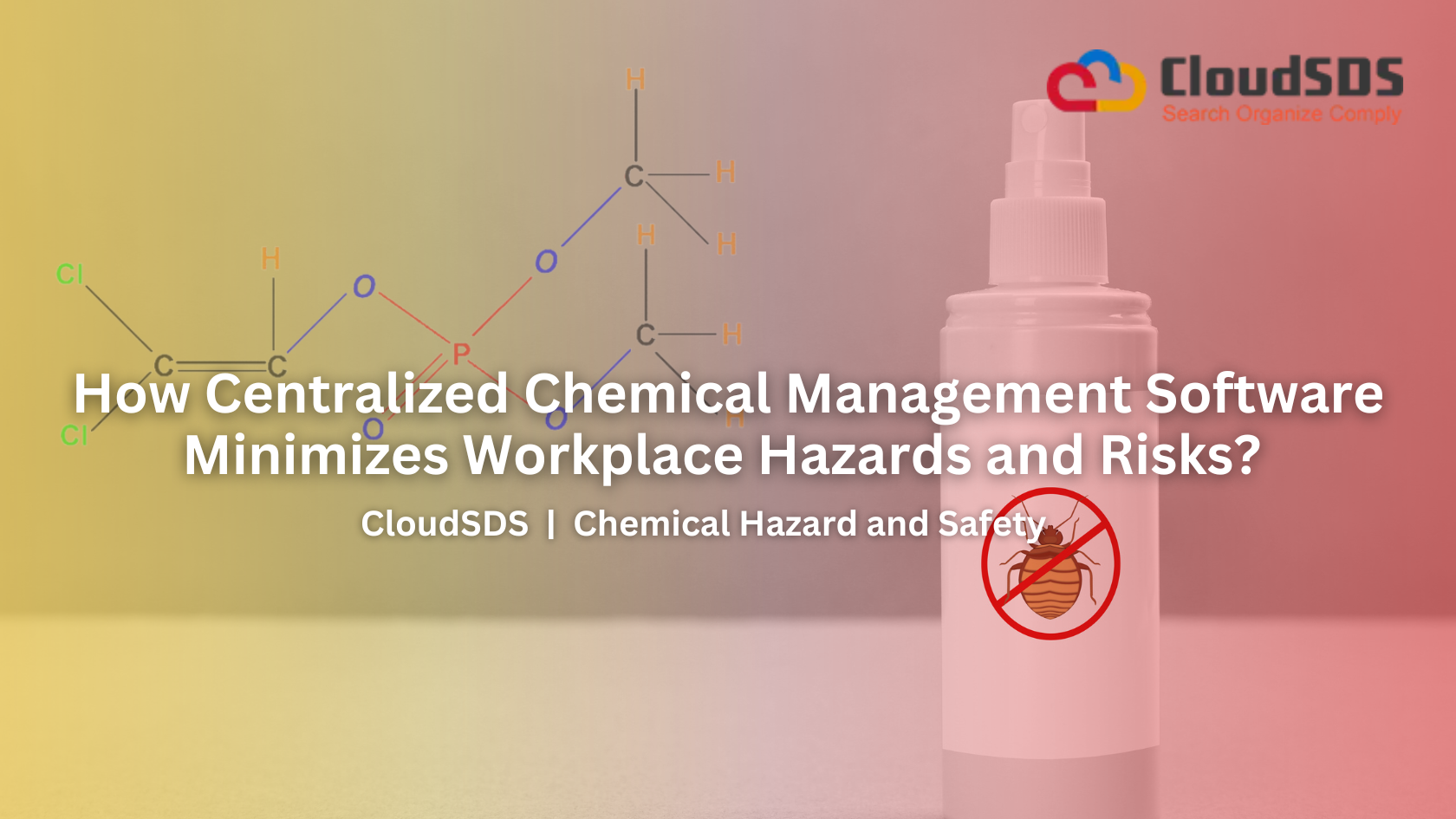Introduction
Dichlorvos (DDVP) is a highly volatile organophosphate insecticide with high acetylcholinesterase–inhibiting toxicity. Although very effective for control of a wide range of pests in agriculture, veterinary use, and public health applications, its acute neurotoxicity, likely carcinogenicity, and environmental persistence require strict exposure controls, high-level safety protocols, and adherence to regulatory limitations in order to minimize risks to human health and ecosystems.
Diving Deep into Dichlorvos Hazards, Safety Measures and Usage
1. A Brief Overview
Dichlorvos (2,2-dichlorovinyl dimethyl phosphate), or DDVP in abbreviated form, has been employed since 1961 for insect control in agriculture, stored-product protection, public health, and veterinary medicine. It acts through inhibition of acetylcholinesterase to interfere with nerve function in the target pests but presents serious risks to non-target organisms, including humans, through comparable biochemical processes.
2. Chemical Properties
Dichlorvos is an amber-to-colorless liquid with a mild alcohol smell. Its density at 25 °C is 1.425 g/cm³, and its boiling point is 140 °C (27 hPa). It is soluble in organic solvents and water. Volatility increases fumigant action but is associated with increased inhalation hazards.
3. Usage and Application
3.1 Agricultural and Stored-Product Uses
Dichlorvos has contact, stomach, and vapor action, and kills aphids, whiteflies, thrips, leafhoppers, armyworms, beetles, and moth larvae on vegetables, fruits, cotton, coffee, tea, and rice. It is used as sprays, aerosols, fogs, or impregnated resin strips (“pest strips”) in grain silos, processing operations, and greenhouses.
3.2 Public Health and Veterinary Uses
As a vector control compound, dichlorvos acts against mosquitoes, flies, and cockroaches in public places. Oral worming pastes for horses, dog flea collars, and livestock dips to manage ectoparasites are veterinary formulations.
4. Mechanism of Toxicity
Dichlorvos irreversibly inhibits acetylcholinesterase and results in an accumulation of acetylcholine at synapses. Insects become paralyzed and die; mammals show hyperstimulation of cholinergic mechanisms resulting in over-salivation, perspiration, muscle fasciculation, respiratory failure, convulsions, and possibly coma or death.
5. Routes of Exposure
- Inhalation: Most significant route in confined areas with the use of pest strips or foggers.
- Dermal Absorption: Contact with skin during handling, spraying, or cleaning up spills.
- Oral Intake: Accidental ingestion of contaminated bait or food.
6. Human Health Hazards
6.1 Acute Toxicity
Dichlorvos is extremely toxic by inhalation, dermal exposure, or oral routes. Acute toxic effects are headache, dizziness, tightness in chest, perspiration, nausea, vomiting, diarrhea, twitching of muscles, confusion, convulsions, and respiratory failure at very high levels. Rodent model occupational inhalation LD₅₀ values are between 50 mg/kg to 139 mg/kg.
6.2 Chronic and Delayed Effects
Chronic exposure may maintain cholinesterase inhibition, which may appear as ataxia, tremors, fatigue, and neurobehavioral effects such as anxiety, depression, and memory loss.
6.3 Carcinogenicity and Mutagenicity
Animal bioassays have shown elevated rates of pancreatic, mammary gland, and forestomach tumors in rats and mice after extended oral exposure. The U.S. EPA categorizes dichlorvos as a Group B2 probable human carcinogen; IARC classifies it as possibly carcinogenic to humans; DHHS is expecting its carcinogenic potential.
6.4 Reproductive and Developmental Effects
Limited human data exists. Animal studies indicate potential reproductive toxicity at high doses, including altered offspring development, but further research is needed.
7. Environmental Impact
Dichlorvos is harmful to aquatic life, bees, and birds at acute exposure rates. Its volatility results in atmospheric dispersion, and water solubility contributes to runoff into streams, which presents hazards to non-target organisms. At recommended applications, acute fish and aquatic invertebrate hazards occur at 0.2-12 mg/L concentration.
8. Exposure Limits and Monitoring
- OSHA PEL: 1 mg/m³ time-weighted average over 10 hours.
- NIOSH REL: 1 mg/m³ in 10 hours; skin notation because of dermal absorption.
- ACGIH TLV: 0.1 mg/m³ inhalable fraction and vapor, 8-hour TWA.
- ATSDR Reporting: Spills ≥10 lb should be reported to EPA.
Biological monitoring by cholinesterase activity analysis in blood offers exposure assessment but does not offer specificity for dichlorvos.
9. Risk Mitigation and Safety Practices
9.1 Engineering Controls
- Enclose mixing and application operations.
- Install local exhaust ventilation at release points.
- Use closed systems or fumigation chambers for structural applications.
9.2 Personal Protective Equipment (PPE)
- Organic‐vapor respirators or supplied-air systems for high-concentration tasks.
- Impermeable gloves, goggles, face shields, and protective clothing.
- Immediate decontamination of skin and removal of contaminated clothing.
9.3 Administrative Controls
- Limit duration and frequency of worker exposure.
- Implement training on handling procedures, spill response, and first aid.
- Post hazard warnings and ensure access to antidotes (atropine and pralidoxime).
9.4 Emergency Response
In case of exposure:
- Take from source, ventilate room.
- Give artificial respiration if necessary.
- Treat with atropine followed by pralidoxime under medical supervision.
- Decontaminate skin with soap and water; flush eyes for a minimum of 15 minutes.
10. Regulatory Status
- United States: EPA’s 1995 voluntary agreement canceled most domestic uses; current review of remaining registrations.
- European Union: Prohibited as plant-protection product since 1988; limited in public health uses.
- Australia: Phased review restricting uses to sealed fumigation and livestock uses where operator exposure is manageable.
- WHO/FAO: Labeling includes skull-and-crossbones, ban on use in inadequately ventilated areas, and purity and inert ingredient specifications.
11. Alternatives and Best Practices
Integrated Pest Management (IPM) tactics minimize the use of dichlorvos by introducing biological control agents, pheromone traps, crop rotation, and alternative insecticides with less mammalian toxicity. Where the use of dichlorvos is unavoidable, compliance with careful dosing, application time, and exposure minimization protects human health and the environment.
Conclusion
Dichlorvos is still an important tool in pest management because it is effective rapidly and versatile. Yet its acute toxicity, likely carcinogenicity, and environmental risks require strict controls. Employers and users need to implement engineering controls, PPE, training, and emergency procedures to reduce hazards. Regulatory policies are increasingly becoming more stringent, keeping pace with the requirement to balance efficacy with safety. A shift to less toxic alternatives where possible is consistent with sustainable pest management and public health objectives.

Leave A Comment